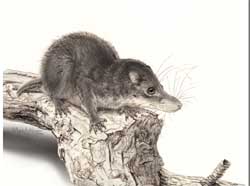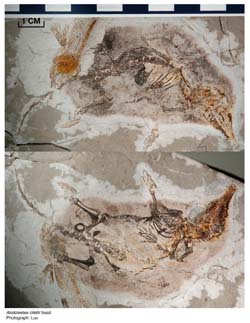

Chinese and American researchers have found a 125-million-year-old new species of mammal from the diversified trove of Jehol Fauna. Their work on the discovery has been published in a recent issue of
Nature.
Teaming up with Dr. Zhe-Xi Luo, curator of vertebrate paleontology at Carnegie Museum of Natural History in Pittsburg, Dr. Li Gang from the CAS Nanjing Institute of Geology and Paleontology made the discovery while examining a specimen collected from the Dawangzhangzi section under Yixian Formation in Lingyaun Prefecture, western Liaoning Province during in an investigation hosted by Prof. Chen Peiji from the Nanjing institute.
The newly discovered mammal, named as
Akidolestes cifellii after its pointed rostrum, is about 12 cm-long and estimated to weigh about 15 to 20 grams; it has triangular teeth cusps and shearing crests for feeding on insects and worms, explained Dr. Li. As the skull, fore-limb, and shoulder of
Akidolestes cifellii show many advanced features of therians, the scientists suggested that it is an extinct relative to the more modern therians including marsupials and placentals.
Akidolestes, however, is very unusual in its vertebral column, pelvis and hind-limb. The back-half of its skeleton is primitive and very similar to egg-laying monotreme mammals. Dr. Luo noted that this new fossil is a chimera of body structures of different mammals. Its front half resembles those of more derived marsupials and placentals, but its back half is unmistakably monotreme-like. Its skeleton is a mosaic of structures that are found either in modern monotremes, or in modern therians, but never together in one animal.
Dr. Luo notes that the new fossil of
Akidolestes is a challenge to the conventional wisdom about how therians split from monotremes in the early mammalian evolutionary history. Its unusual combination of advanced therian features and the primitive monotreme features can be the consequence of convergence, in which the hind-limb of Akidolestes has re-developed the monotreme-like features.
"Metaphorically, this newly discovered fossil mammal has a forelimb posture and gaits like those of a squirrel, with elbows tucked under its body, but its hind-limb would be sprawling with a posture that is similar to a lizard," said Dr. Luo. "It is quite unusual that this mammal re-acquired some primitive hind-limb feature."
After the extinction of dinosaurs, the Cenozoic world became the paradise of mammalians, explains Dr. Li. Paleontology research shows many Tertiary mammalians might be originating from Asian continent and then made their way to North America. This theory was first suggested by Dr. Chris Beard of the Carnegie museum. The new research
Akidolestes cifellii indicates the dating of the predicated scenario might be traced back to Cretaceous.






